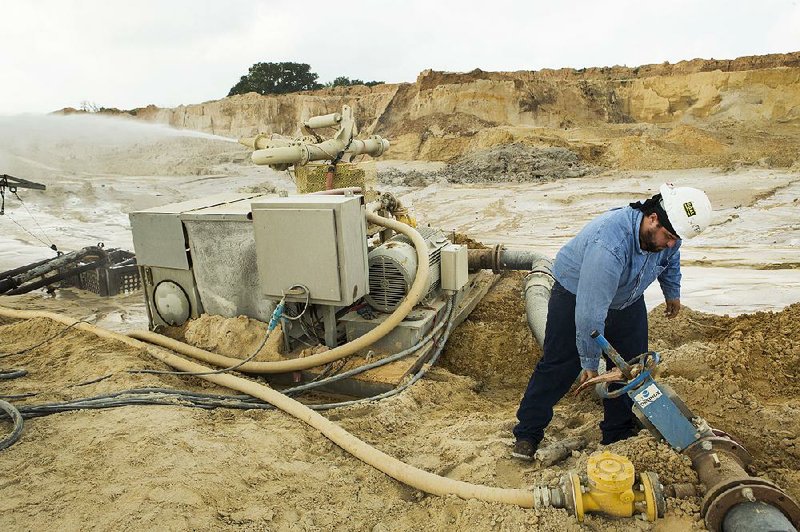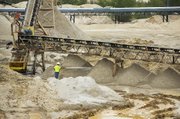KOSSE, Texas -- In a deepening pit in this small town southeast of Waco, workers aim a high-pressure water cannon that reduces small hills of claylike sand into a watery slurry that is filtered, processed, dried into fine particles and loaded onto trucks bound for hydraulic-fracturing operations across Texas.
It will take up to 1,000 trucks to haul enough of this sand to frack a single large well.
As drilling has recovered in recent months, particularly in West Texas' Permian Basin, the sand mining industry has exploded.
It is producing more than ever to meet the demand of an oil and gas sector that is using up to 20 times more sand per well than it did during peak of the last energy boom. Across the state, already home to nearly 10 frack sand mines, operators are moving to expand quickly, setting the stage for Texas to become a bigger player -- and competitor -- in an industry long dominated by purer Wisconsin and Minnesota sands.
At the same time, the growth of sand mining is opening a new front in the battle between the energy industry and environmentalists, who argue the mines despoil pristine land and create health hazards by kicking up silica dust, which has been linked to lung cancer, tuberculosis and other lung diseases when inhaled.
In Atascosa County, south of San Antonio, residents are fighting a 300-acre sand mine proposed by Preferred Sands of Radnor, Pa., citing health risks, potential well-water contamination, truck traffic and potential damage to the site of the 1813 Battle of Medina, a bloody fight in the early years of Mexico's long war for independence.
"What's more important? Breathing or having water to drink?" said neighboring resident Jessie Hardy, who voices local air and water pollution concerns through an opposition group, Not Just Dust.
Sand companies contend that they follow regulations to limit silica air pollution and that they have almost no carbon emissions. They are pressing ahead to take advantage of demand and prices that have doubled in a little over a year. Several new sand mines or expansions, covering thousands of acres, are proposed in Texas.
At the 300-acre, Superior Silica Sands mine in Kosse owned by Emerge Energy Services, employment over the past year has rebounded to 30 from its oil-bust low of four, and the company is looking to acquire another Texas sand mine any day now and expand it.
"People were skittish in the beginning if the recovery was real," said the mine manager Dave Heagle. "But it seems like the real deal now."
Sand is mixed into fracking fluids that crack shale rock to prop open the fissures to allow oil and gas to escape, hence the industry name "proppant" to describe the fine grains. The largest wells now consume up to 25,000 tons -- 50 million pounds -- of sand each, up from 1,500 tons, or about 3 million pounds, per well during the boom years through 2014.
When oil prices crashed and companies sought ways to lower production costs, drillers began experimenting with the idea of using more sand -- cheaper than chemicals and ceramic proppants -- to increase oil and gas output.
Oil prices and U.S. drilling rig counts have doubled from their 2016 lows. The sand comes into play when the drilling rigs finish their jobs.
Sand usage slowly rose during the shale oil rush from 2011 to 2014 with the thought that it would peak and reach a point of diminishing returns, said George O'Leary, director of oil services research at Houston energy investment firm Tudor, Pickering, Holt & Co.
"What we saw was the inverse," O'Leary said.
Instead, after oil prices began plummeting in late 2014, the industry consensus last year became, "We just want to pump a whole lot more sand," O'Leary said. "They took a lot of chemistry out of the well."
The approach seems to be working and companies are increasingly pushing further in that direction with the fixation on sand. It's viewed as the best bang for the buck in wells.
Nationwide, fracking-sand demand is expected to double this year to about 80 million tons -- from roughly 40 million last year -- and potentially hit 120 million tons in 2018, he said.
The 2014 peak only consumed 54 million tons. Wells today typically use at least 5,000 tons each.
Oklahoma City's Chesapeake Energy attracted attention late last year when it coined the term "propageddon" to describe using more than 50 million pounds of sand in a single gas well in northwest Louisiana with the stated goal of "unleashing hell" on every gas molecule.
Chesapeake claims the effort increased gas output by 70 percent.
SundayMonday Business on 04/16/2017


